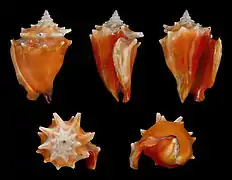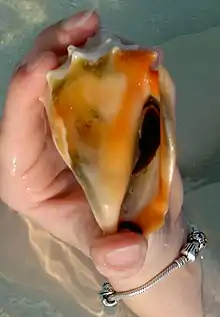| Fighting conch | |
|---|---|
 | |
| Five views of a shell of Strombus pugilis | |
| Scientific classification | |
| Domain: | Eukaryota |
| Kingdom: | Animalia |
| Phylum: | Mollusca |
| Class: | Gastropoda |
| Subclass: | Caenogastropoda |
| Order: | Littorinimorpha |
| Family: | Strombidae |
| Genus: | Strombus |
| Species: | S. pugilis |
| Binomial name | |
| Strombus pugilis | |
| Synonyms | |
| |
Strombus pugilis, common names the fighting conch and the West Indian fighting conch, is a species of medium to large sea snail, a marine gastropod mollusk in the family Strombidae, the true conchs.
S. pugilis is similar in appearance to Strombus alatus, the Florida fighting conch.
Shell description

The maximum recorded shell length is 110 mm[1] or up to 130 mm,[2] commonly to 90 mm.
Like other species in the same genus, Strombus pugilis has a robust, somewhat heavy and solid shell, with a characteristic stromboid notch. It has a well-developed body whorl and a short and pointed spire. It presents 8 to 9 whorls,[3] each of them having a single row of subsutural spines, becoming larger towards the last whorl.[2] These spines, however, may be less conspicuous or even absent in some populations.[4] Its aperture is relatively long and slightly oblique.[3] The posterior angle of the outer lip is distinct, projecting in the posterior direction in an erect fashion.[5] The operculum is sickle-shaped, similar to several other Strombus snails.
The shell color varies from salmon-pink,[3] cream or yellow to light or strong orange, and the interior of the aperture is usually white. The anterior end presents a dark purple stain,[2] which is one of the diagnostic characters of this species, and is absent in Strombus alatus.
This species is closely similar to Strombus alatus, which has a more northerly range. Strombus alatus shells have less prominent subsutural spines and a slightly more projected outer lip. Some scientists have treated the two as distinct species; others as subspecies.[6] In an extensive study of the Stromboidea in 2005, Simone provisionally treated them as distinct species, but observed that "no spectacular morphological difference was found [and] all related differences, even those of the genital system, can be regarded as extreme of variation of a single, wide distributed, variable species."[7]
Distribution
Strombus pugilis lives in Bermuda, southeastern Florida, the Caribbean Sea, and south to Brazil.[2]
Phylogeny
| ||||||||||||||||||||||||||||||||||||||||||||||||||||||||||||||||||||||||
| Phylogeny and relationships of Eastern Pacific and Atlantic Strombus species, according to Latiolais et al. (2006)[8] |
A cladogram based on sequences of nuclear histone H3 gene and mitochondrial cytochrome-c oxidase I (COI) gene showing phylogenetic relationships of (32 analyzed) species in the genus Strombus and Lambis, including Strombus pugilis, was proposed by Latiolais et al (2006).[8] In this hypothesis, Strombus pugilis and Strombus alatus apparently share a common ancestor, and are possibly close related.[8]
Ecology
Habitat
This sea snail lives on sandy and muddy bottoms,[2][4] from the intertidal zone[4] to depths between 2 and 10 m.[5]
The minimum recorded depth for this species is 0 m; the maximum recorded depth is 55 m.[1]
Life cycle
During a long period in the initial stages of its development, the Strombus pugilis larvae feed mainly on plankton.[2] Studies indicate that some populations of Strombus pugilis may reproduce throughout the year.[9]
Reproduction orgies have been observed, on silty sand at 8-10 m. depth,
with egg cases littering the bottom, and obvious copulation in progress across a fairly large area.
Feeding habits
Strombus pugilis is known to be a herbivore, feeding on plants and algae.[10]
Human uses
The flesh of Strombus pugilis is edible.[3] It is usually cooked by boiling, and is consumed by local fishermen.
Strombus pugilis is used as a zootherapeutical product for the treatment of sexual impotence in the traditional Brazilian medicine of the Northeast region of Brazil.[11]
The shell is commonly used as a decorative item and is sold in local markets as a souvenir.
References
- 1 2 Welch J. J. (2010). "The "Island Rule" and Deep-Sea Gastropods: Re-Examining the Evidence". PLoS ONE 5(1): e8776. doi:10.1371/journal.pone.0008776.
- 1 2 3 4 5 6 Leal, J.H. (2002). Gastropods. p. 99-147. In: Carpenter, K.E. (ed.). The living marine resources of the Western Central Atlantic. Volume 1: Introduction, molluscs, crustaceans, hagfishes, sharks, batoid fishes, and chimaeras. FAO Species Identification Guide for Fishery Purposes and American Society of Ichthyologists and Herpetologists Special Publication No. 5. 1600p.
- 1 2 3 4 Rios, E. C. (1994). Seashells of Brazil (2nd ed.). Rio Grande: FURG. ISBN 85-85042-36-2.
- 1 2 3 Simone, L. R. L. (2005). "Comparative morphological study of representatives of the three families of Stromboidea and the Xenophoroidea (Mollusca, Caenogastropoda), with an assessment of their phylogeny" (PDF). Arquivos de Zoologia. São Paulo, Brazil: Museu de Zoologia da Universidade de São Paulo. 37 (2): 141–267. doi:10.11606/issn.2176-7793.v37i2p141-267. ISSN 0066-7870. Archived from the original (PDF) on 5 March 2012.
- 1 2 Cervigón, F. et al. (1993): FAO species identification sheets for fishery purposes. Field guide to the commercial marine and brackish-water resources of the northern coast of South America. Rome, FAO. 513 p.
- ↑ Simone (2005): Comparative Morphological study of representatives of the three families of Stromboidea and the Xenophoroidea (Mollusca, Caenogastropoda), with an assessment of their phylogeny Archived 5 March 2012 at the Wayback Machine, p. 142.
- ↑ Simone (2005): Comparative Morphological study of representatives of the three families of Stromboidea and the Xenophoroidea (Mollusca, Caenogastropoda), with an assessment of their phylogeny Archived 5 March 2012 at the Wayback Machine, p. 169.
- 1 2 3 Latiolais J. M., Taylor M. S., Roy K. & Hellberg M. E. (2006). "A molecular phylogenetic analysis of strombid gastropod morphological diversity". Molecular Phylogenetics and Evolution 41: 436-444. doi:10.1016/j.ympev.2006.05.027. PDF.
- ↑ Cardenas, E.B., D. Aldana Aranda, and G. Martínez Olivares. (2005). Gonad development and reproductive pattern of the fighting conch Strombus pugilis (Lineé, 1758) (Gastropoda, Prosobranchia) from Campeche, Mexico. Journal of Shellfish Research 24(4):1127-1133.
- ↑ Robertson, R. (1961). The feeding of Strombus and related herbivorous marine gastropods. Natul. Nat. 343: 1-9
- ↑ Alves R. R. N. 2009. Fauna used in popular medicine in Northeast Brazil. Journal of Ethnobiology and Ethnomedicine 2009, 5:1. doi:10.1186/1746-4269-5-1. The species is incorrectly spelled in the reference as Strombus puginis.
- Rosenberg, G., F. Moretzsohn, and E. F. García. 2009. Gastropoda (Mollusca) of the Gulf of Mexico, pp. 579–699 in Felder, D.L. and D.K. Camp (eds.), Gulf of Mexico–Origins, Waters, and Biota. Biodiversity. Texas A&M Press, College Station, Texas.